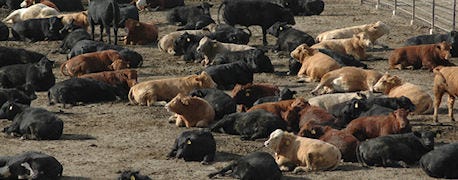May 5, 2014

Temperamental cattle appear to be less susceptible to lung damage and related respiratory diseases, but at the same time may produce lighter-weight carcasses with decreased quality grade, according to a USDA Ag Research Service, University of Nebraska-Lincoln and Kansas State University study.
Ty Schmidt, Joe Buntyn, Chris Calkins and Kathy Domenech of UNL; Jeff Carroll and Jeff Daily of USDA-ARS; and Justin Waggoner of Kansas State University prepared the study.

Temperamental cattle show fewer respiratory issues, but lower quality grades in UNL-USDA-Kansas State study
The research team used 2,800 cattle at a commercial feedlot to determine cattle temperament solely by exit velocity upon arrival to identify the impact temperament had on feedlot performance. Infrared sensors were attached to the processing chute and alleyway and used to time how fast cattle exited the processing chute.
Once exit velocity was determined, within each pen the fastest 20% were classified as temperamental and the remainder deemed non-temperamental, according to Schmidt.
Related: 4 Tips For Late Spring and Early Summer Pasture Management
Exit velocity, the researchers determined, is the only objective and practical measurement of temperament that can be applied in a commercial setting. Scientists sought to evaluate the impact of temperament on animal health and carcass merit with an eye toward using the data as a sorting tool within feedlots.
After scientists determined exit velocity, the cattle were maintained in their original pens, not sorted based upon temperament, and finished. At the end of the finishing period, the research team followed the cattle to the packer and evaluated lung damage, liver abscesses and collected all the variables for carcass data.
Respiratory issues
One of the major findings of the trial was the difference in lung damage associated with respiratory disease. The results suggest that the non-temperamental cattle had more observable damage to the lung, indicative of the animal being impacted by respiratory challenge, when compared to cattle classified as temperamental.
~~~PAGE_BREAK_HERE~~~
"The temperamental cattle may have more resilient immune systems," Carroll said. "Research has suggested that temperamental cattle have an altered immune response and display limited clinical symptoms of illness and this altered immune response may be a more resilient immune response compared to non-temperamental based upon these findings."
Schmidt and colleagues also found that cattle classified as temperamental had lighter carcass weight at harvest and decreased quality grades. More than 53% of the non-temperamental cattle received a quality grade of choice, compared to 49% of the temperamental animals.
Schmidt said the findings from this trial "suggest that utilization of temperament may be a viable management tool for feedlots. It might provide for a unique management strategy that might increase returns on these temperamental animals."
Related: China Looks to Import More Beef in Next Five Years
With the difference in lung damage in the temperamental cattle at the time of harvest, and previous research indicating limited clinical signs of illness in temperamental cattle, segregation may allow for some modifications to the processing procedures and management of these cattle to take advantage of this alterations, Schmidt said.
Alterations may also be introduced in terms of nutritional management, or even modification of days to feed to overcome the decreased body weight of the temperamental cattle. However, before this type of segregation can be used in commercial feedlot, there is still a need to further evaluate this methodology, Schmidt added.
The next step for the research team is to determine temperament upon arrival and then sort the cattle based upon temperament.
Source: UNL
You May Also Like




